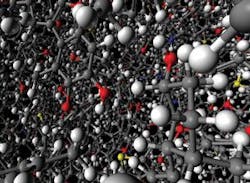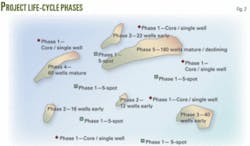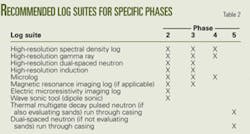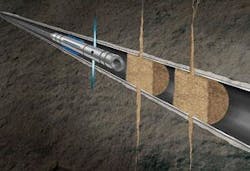This series on unconventional gas resources concludes with a discussion of technologies used in the recovery of coalbed methane and potential future research areas. The series has reviewed three main types of unconventional gas reservoirs: tight-gas, shale, and coalbed methane. The flow mechanisms of the different reservoirs increase in complexity from Darcy flow to Fick’s diffusion flow, and include combinations of other mechanisms.
Many different technologies and methods have been effective in producing unconventional gas. Part 1 (OGJ, Dec. 17, 2007, p. 39).discussed tight gas reservoirs and included such processes as hydrajet fracturing.3 Part 2 (OGJ, Dec. 24, 2007, p. 41) discussed shale gas and a variety of drilling, logging, and fluid treatment technologies.
Sorption
Coal’s unique gas-storage mechanism is known as the “sorption” process, whereby gas molecules are packed tightly within the coal-matrix molecular pore system (Fig. 1). Concentration gradient causes gas to be released from the tens to hundreds of square meter surface area per gram of coal. Methane and other light gases diffuse (Fick’s Law) from the coal matrix toward a lower concentration.
Coal can store many times its equivalent volume in gas because the gas molecules are packed tightly onto the surfaces of the coal. Gas adsorbed onto and within the coal macerals diffuses through a complex flow path of pores and cleats of varying sizes. The physics of migration is controlled by diffusion or diffusivity at various scales.
Some coals are diffusion limited, while others are not. Water and sometimes gas exist at equilibrium gas saturation. Concentration gradients are most readily generated by removing this water or gas from the cleat system by reducing reservoir pressure.1
Methane sorption isotherms are used to help define a relationship between gas storage capacity and reservoir pressure; from this, a critical desorption pressure can be determined. Conventional porous-media fluid-flow concepts, such as Darcy’s law, relative permeability, and permeability anisotropy quantify reservoir mechanics after gas is released from the coal matrix. Methane extraction then occurs via a concentration gradient induced by removal of the free water or gas from the cleats as referenced above with effective stimulation or tailor-made well designs.
Coalbed methane
Conventional concepts can quantify reservoir mechanics after gas is released from the coal matrix, but coalbed methane (CBM) projects require earlier and more thorough evaluations than conventional projects. Therefore, CBM technologies, when viewed from a development life-cycle perspective, must depart from a conventional oil and gas approach in order to stack the odds for a commercial success.
Historically, CBM projects include a few top-tier wells and many average-to-marginal wells. Because CBM prospectors rarely understand the up-front controlling factors that make a good or bad well, an investment in a regional view and multiwell approach early in the program is necessary so that the economically viable wells or acreage can be identified during start-up.
In a technology-play CBM project, innovative applications of enabling technologies allow prospectors and operators to reduce cycle time before the first commercial gas sales. They can also screen and high-grade potential projects, add value to preproduction knowledge gathering, and validate economic forecasts that often must project much further into the future than those of conventional oil and gas reservoirs.
Life-cycle concept
CBM projects have five distinct life-cycle phases:
- Regional resource reconnaissance.
- Local asset evaluation.
- Early development.
- Mature development.
- Declining production.
A large-scale project may contain multiple localized projects, resulting in the simultaneous occurrence of all life-cycle phases.
Fig. 2 presents a scenario in which an operator has leased several hundred thousand continuous acres of coal rights. The operator has been developing the asset for more than 15 years. Several areas in the lease are mature or experiencing declining production, but other areas have not yet been evaluated for production potential.
In Phase 1, an operator determines whether a property has adequate production potential to justify an acquisition and exploration.
In Phase 2, evaluations determine whether a specific area should be exploited and the most economic development methodology for exploiting it.
In frontier exploration plays or basins, cycle time and costs must be optimized. The economic issues of remote operations further drive development of innovative strategies to help reduce evaluation time and allow go/no-go Phase 3 decisions. Inherent highly variable coal-seam characteristics over short distances cause difficulties in extrapolating core hole and single test-well results. Consequently, basin-wide evaluations or localized testing should be performed before a multiwell production pilot or development phase activity.
In Phase 3, initiation of development drilling in potential areas and attaining targeted project production is critical for capital investment.
Phase 4 involves maintaining project production and economic targets through development of marginal areas, infill drilling, and remediation.
Phase 5 can result in secondary recovery efforts as a means of extending economic viability. Declining production requires plugging of unproductive wells, removing equipment, and restoring the site while maintaining a positive cash flow.
Fig. 3 illustrates a conceptual flow path for an example project. A phased approach may include separation of the single-cased well pilot holes as a Phase 1 effort. This phased approach can be further evolved into a “minipilot.”
Enabling technologies
Over the years, many technologies and operating practices have evolved to help make CBM a viable energy resource. Ten specific enabling technologies may offer the best chance for projects to reach their life-cycle potential and span multiple life-cycle phases (Table 1):
1. Geospatial well-pattern optimization. CBM geospatial well-pattern optimization requires an understanding of CBM production mechanics and reservoir simulation for production and economic forecasting. Although well spacing is usually a north-south and east-west grid, optimized well patterns are determined by reservoir characteristics, completion effectiveness, well-stimulation effects, drilling and completion costs, operating costs, and outside factors.
For minimal cost, virtual simulation enables economic assessment, well-pattern comparisons, and completion options for hundreds of virtual wells.
2. Core and core analysis. Scientific analysis of coal core can be critical to the success of Phases 1 and 2. Calculating gas in place from direct core measurements is a major first step in assessing methane gas reserves trapped in the rock matrix. Gas-content determination is largely independent of the core porosity and permeability, but is a function of methane adsorption within the coal macerals.
Prospectors may tend to rely on nonspecific seam lithotypes and assumed values for adsorption isotherms. Gas contents are calculated with assumed isotherms, reservoir pressures, and gross seam thickness. Although these estimates are appropriate during early prospect evaluation, they must be validated through direct-core measurement in Phase 2. A complete coal-seam anatomy can be obtained and applied to the macroscale reservoir.
3. Well logging. Significant technical breakthroughs in well logging have been developed specific to CBM. Perhaps the greatest advances involve log-processing methods and core-log integration techniques. Table 2 provides recommended log suites for projects in Phases 2 through 5.
Electric microimaging (EMI) logging may provide the closest thing to a continuous core as currently possible. It can be integrated with the whole core so that grayscale levels can be correlated to discrete core lithology. Such integration can be performed in one well and applied across the field or basin that lacks core information.
4. Cleat permeability determination. Three technologies are potentially available for cleat permeability determination and are applied predominantly through Phases 2 and 3:
- Openhole discrete-seam drillstem testing (DST).
- Interference testing and injection fall-off.
- G-function derivative analysis.
DST technology can enable the high-grading of discrete seams for subsequent production during the corehole process. Multiwell interference testing can enable the acquisition of far-field regional cleat permeability and permeability anisotropy. G-function analysis, primarily used for comparing regional variations, can enable near-field qualitative cleat permeability information to be obtained in conjunction with the hydraulic fracturing parameters.
5. Primary hydraulic fracture stimulation. Very few coal-seam gas reservoirs can produce commercial rates of methane without some type of primary production enhancement. Three primary proven stimulation technologies have been developed for enhancing CBM production: cavitation, underreaming, and hydraulic fracture stimulation. Historically, the most effective technology appears to be hydraulic fracturing although novel stimulated horizontal and complex wells are rapidly becoming viable alternatives to traditional vertical hydraulically fractured wells.
In the early phases, a technically, rather than economically, optimal fracturing system is critical to acquire valid gas and water producibility data for subsequent reservoir simulation and sensitivity analysis. Early development of fracture-design simulation model(s) can match the outcome of the development-phase treatments and provide dependable predictions for future economic fracture treatments.
Recent technological developments have enhanced hydraulic fracturing for CBM resource evaluation. Because the indiscriminate application of fracturing fluids to coal reservoirs contributes to production performance, identifying an optimal fracturing system during resource evaluation phase is critical.
Economic constraints regarding mobilization and logistics, especially in frontier regions where little or no service infrastructure exists, largely drive fracture design decisions. If the goal of a single test well in a frontier region is to demonstrate that free gas can be produced to verify gas saturation, then a relatively small, low-cost hydraulic fracture design may be more appropriate than one designed for full-scale production.
6. Secondary production enhancement. During the final two life-cycle phases, technologies focusing on secondary production enhancement are increasingly important for extending the life of the CBM field.
Technologies enabling the extension of Phases 4 and 5 include the following:
- Hydraulic refracturing of previously fractured wells.
- Hydraulic fracturing of previously cavity-completed wells.
- Chemical-enhancement additives designed to mitigate specific impairment mechanisms included as part of the hydraulic fracturing system. Such remedial “backflush” technologies can be economic, repeated on the same well, and extend Phase 4 for years.
7. Infill drilling. Tapping into new reservoirs in a development field is an enabling technology because it has significantly helped extend Phases 4 and 5 of a mature CBM prospect. Because infrastructure investments have been capitalized, combining this approach with secondary production-enhancement methods offers a solution to stopping or stabilizing field or basin-wide production declines.
Reservoir modeling and history-matching the field’s cumulative production can help identify infill-drilling candidates. Combined with geospatial well-pattern optimization, infill drilling can be optimized for a given asset within a basin or field. Emerging technology involving multilateral and directional drilling may eventually replace vertical-well infill drilling for CBM. Currently, economics are looking more favorable for widespread application of innovative multilateral and directionally drilled well completions in coal.
8. Treatment selection. Determining an optimum stimulation treatment involves experimentation, but the following guidelines can help operators avoid misapplications and decrease the learning curve. The following steps can be used for planning treatments in areas where few or no CBM completions have been performed.
Typically, coalbeds are categorized by:
- Type of coal, coal thickness, and stratigraphy.
- Proppant needs and desired proppant concentrations.
- Field economics, including service costs, accessibility and availability, and potential gas rates.
- Cleanup concerns or needs for long-term dewatering of well.
- Job design process, including frac-modeling simulation (pressure-dependent leakoff (PDL) concerns, rate effects, etc.).
When a well contains several coal seams that will act as producing zones, differences between zones may prevent the success of a single fracture design. Economics seldom allow operators to pump optimum jobs for each zone, even when the zones are fractured separately.
9. Optimizing hydraulic technology. Helping to define hydraulic technology should be considered early and evolve throughout the entire lifecycle, particularly in the local asset evaluation, single test well, and five-spot subphases. Fracturing fluids selection and optimization for hydraulic-fracturing technology is key in the local asset evaluation, single test well, and five-spot subphases. In these early phases, a technically optimal fracturing system is critical in acquiring valid gas and water producibility data for subsequent reservoir simulation and sensitivity analysis. Later in the well’s life, emphasis can be shifted from technology to efficiency optimization.
Realistically, the time in which an optimum fracturing design can be achieved depends on several factors, including the following:
- The volume of available information about the seam(s) that will be fracture stimulated.
- How this CBM reservoir responds to fracturing compared to existing CBM reservoirs. Fracturing treatments that incorporate the use of fines control and surface modification agent (SMA) provide both fines and proppant flowback control. This allows the operator to produce the wells with the pump at or below the lowest perforations for optimum efficiency. Increased run times with fewer workovers improve the dewatering efficiency, shortening the time to maximum gas desorption.
- The technical background and CBM stimulation experience of the team member(s) responsible for developing the fracturing program.
10. Multiseam pinpoint hydraulic fracturing. One of the most significant enabling technologies for CBM in recent years involves technologies that enable the hydraulic fracturing of multiseam completions.
Another fracture stimulation option for multiseam completions (not involving coiled tubing) is the conventional “Perf & Plug” method using conventional wireline perforating and composite bridge plugs that set quickly and are easily drilled out at the end of the completion.
Using coiled tubing, there are several new methods for isolating and fracturing individual coal seams, some of which involve hydra-jet perforating (Fig. 4). These methods were developed to minimize or eliminate non-productive time by planning the entire completion to be performed in a single trip. Coiled tubing fracturing technology allows placement of 30,000 to 100,000 lb/proppant per coal seam With pump time of about 1 hr/seam, three to seven stages have been successfully treated in a single day. For shallow CBM wells, as many as 24 intervals in two separate wells have been fracture stimulated in a single day with the same crew and equipment.
Defeating coal fines
A patented fines locking backflush service (FLBS) incorporating aqueous tackifier technology provides a process to help remove wellbore damage while locking down formation fines to restrict their mobility (CoalStim). It can be used during the initial stimulation job or in remedial stimulation jobs. FLBS chemicals initially act as “clotbusters,” breaking apart the internal bridges and agglomerates, and then act as “clot-formers,” imparting a “tacky” surface to the coal particle surfaces.
FLBS has been used to return hundreds of CBM wells in the western US to their initial production rates and extend the life of these highly profitable fields.
Other key functions of the FLBS chemistry are to degrade residual polymer remaining from previous gelled-fracturing operations and dissolve in situ geochemical precipitates or carbonate scales that may be contributing to premature production declines.
Coal fines tend to collect in both proppant and cleat porosity; eventually, such plugging may damage permeability and conductivity. FLBS causes fines to segregate and then adhesively bond together in larger groupings that bond onto proppant or cleat surfaces while keeping flow channels open to flow.
Benefits of applying FLBS postfracture service in mature CBM fields include:
- Extend well productive life.
- Economically treat wells/field.
- Accelerate well pay out.
- Increase success rate.
- Lower financial risk.
- Add significant reserves to existing assets.
The fines control technology can be applied in both primary stimulation and remedial treatment application modes.
Field case history
A look-back study was conducted from a mature Phase 4 CBM project in the western US in which a total of 495 FLBS treatments were reviewed. The objective of the project was to extend the life of the field as it was approaching Phase 5. Results showed an average per well gas increase of 15,696 Mscf/well and 312 bbl/well increase in water over a 6 month period. This translated to an overall 4,500 % increase in gas volume and a project ROI of over 2000%.
Future technologies
No one individual technology can make unconventional assets profitable. A comprehensive holistic approach must be taken into account beginning with seismic and continuing through to last stage of production including plug/abandonment. Future exploitation of unconventional gas sources will require development and-or refinement of several technologies:
- Deformable proppants
- Partial monolayer proppant designs
- Proppant transport
- Improving proppants and fluids that are better tailored to formations.
- Create a better understanding of reservoirs by improving reservoir modeling and description
- Better prevention of circulation losses while drilling.
- Recycling and purification of water used in well-service functions.
- Reducing emission to the atmosphere
- Minimize land use through centrally located rigs and fixed-plant hydraulic fracturing operations serving many wells.
- Improved efficiency.
- Increasing simultaneous operations, e.g., drilling, stimulation, and production at the same time.
- Improving automation and realtime operations for improving learning and reducing manpower requirements.
- Improving recovery processes for ultra low pressure reservoirs, including improving artificial lift and improved recovery processes
Acknowledgments
The authors thank Halliburton management for their support and permission to publish the unconventional article series.
References
- Blauch, M.E., Weida, D., Mullen, M., and McDaniel, B.W., “Matching Technical Solutions to the Lifecycle Phase is the Key to Developing a CBM Project,” SPE 75684, SPE Gas Technology Symposium, Calgary, Apr. 30-May 2, 2002.
- Smith, Michael, Blauch, Matt, and Welton, Thomas, “Process increases CBM production,” Hart’s E&P, November 2004.
- Surjaatmadja, J.B., Grundmaan, S.R., McDaniel, B., Deeg, W.F.J., Brumley, J.L., and Swor, L.C., “Hydrajet fracturing: An Effective Method for Placing Many Fractures in Openhole Horizontal Wells,” paper SPE 48856, SPE International Conf. & Exhibition, Beijing, Nov. 2-6, 1998.
- East Jr., Loyd, Grieser, William, McDaniel., B.W., Johnson, Bill, and Fisher, Kevin, “Successful Application of Hydrajet Fracturing on Horizontal Wells Completed in A thick Shale Reservoir,” paper SPE 91435, 2004 SPE Eastern Regional Meeting, Charleston, West Virginia, 15-17 September 2004.
- Romer, W. C., Phi, M. V., Barber, R. C., and Huynh, D. V., “Well Stimulation Technology Progression in Horizontal Frontier Wells, Tip Top/Hogsback Field, Wyoming,” paper SPE 110037, 2007 SPE Annual Meeting, Anaheim, Nov. 11-14, 2007.
The authors
Gary Rodvelt ([email protected]) began work in the Midcontinent (Illinois) division and now works on Applalachian basins unconventional reservoirs. In 28 years, he has worked in management, sales/marketing and engineering. Rodvelt graduated from Kansas State University with nuclear engineering (BS). He is a member of Society of Petroleum Engineers and the Appalachian Geologic Society and has published numerous coalbed methane papers and other unconventional reservoir focused papers.
Matt Blauch ([email protected]) is a principal technical professional in Halliburton’s production enhancement group. He has more than 20 years’ experience in the industry, including 15 years working with unconventional gas, focused on CBM and shale gas. He graduated from Juniata College, Huntingdon, Penn., with a BS (1982) in geology and then earned an MS (1988) in geology from the University of Akron. He is a member of the American Association of Petroleum Geologists and SPE.
Richard D. Rickman ([email protected]) is a senior scientist (chemist) at Halliburton’s Duncan Technology Center in Duncan, Okla., where he works in both the fracturing and sand control groups. Rickman graduated from Texas A&M University with a PhD (2004) in chemistry. He is a member of SPE and the American Chemical Society.
John Ringhisen ([email protected]) has been with Halliburton for 36 years in various field pumping services assignments, sales and service line management positions. Based in Oklahoma City, he concentrates on cementing issues for the midcontinent area. Ringhisen received a BS (1969) in petroleum engineering from Marietta College, Ohio, and he is a member of SPE.
Loyd East ([email protected]) is currently global pinpoint stimulation manager at Halliburton. He has been working in the oil and gas industry for more than 26 years. East’s most recent work is in multiple-interval well completions and horizontal well stimulation. His previous assignments include engineering positions in technology and instructor at the Halliburton Energy Institute. East earned his BS (1980) in agricultural engineering from Texas A&M University; he is a member of SPE.
Glenda Wylie’s biography was published in Part 1, OGJ, Dec. 17, 2007, p. 45.








